Why Mondograss is My Favorite
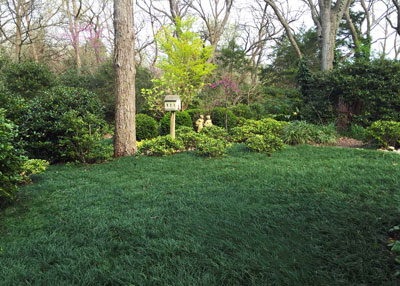
We had ivy growing here until June 2007, when we had 20 inches of rain in one month. I reworked the bed, planted the mondograss and have never looked back.
It’s the plant with three common names. “Mondograss.” “Monkeygrass.” “Lily turf.” OK, I’ve never really heard anyone use that last name, but you’ll see it in books. They’re all the same plant botanically: Ophiopogon japonicas. By whatever name, however, it’s a stellar performer in Texas conditions. And it’s a long-proven winner at our place as well. All of these photos are from the Sperry home landscape.
Reasons It’s My Favorite Groundcover:
If I’m going to claim mondograss as my go-to groundcover, I need to explain why. For purposes of this discussion, please remember that we live in a pecan forest.
• Shade-tolerant. It handles shade perfectly. Anything from total shade to morning sun with afternoon shade. It just won’t tolerate hot, reflective afternoon sun against concrete or brick.
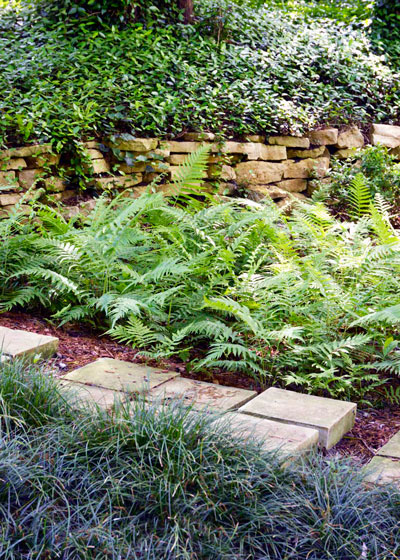
Photo: This is some of the heaviest shade in our landscape, and mondograss takes its place right in with woodferns.
• Prevents erosion. No groundcover we grow roots as tenaciously. If you plant it closely enough, within just a few months there will be enough roots to hold back all but the strongest of currents.
• Easily cleaned. My pecan leaves have little stems called petioles. They also have several leaflets per leaf. All of that snags in traditional trailing groundcovers, making blowing fallen leaves a difficult task. Not so with mondograss. A power blower can have it cleaned out in minutes. You can then mow and bag the shredded leaves off to the side and use them either as mulch or in the compost.
• Evergreen. It’s dark green, and that makes it the perfect “carpet” on which a fine landscape can be developed. It looks pretty much the same 12 months a year.
• Highly pest-resistant. I have almost never seen any problem with my mondograss beds. One year a small area struggled due to poor drainage, but that’s pretty much it.
• Affordable to plant. Once you have a bed of mondograss going, you can pretty well propagate your own. I dig around the edges and remove 3 to 4 inches of the groundcover. Leaves of the remaining planting arch to cover the bare soil, and it spreads right back within a few months.
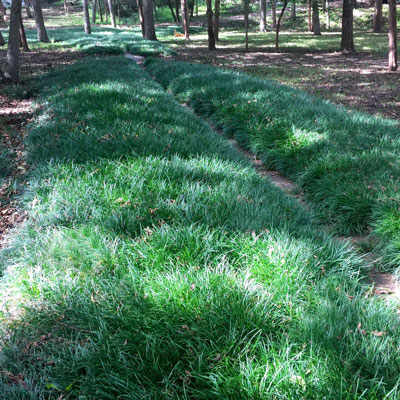
Photo: This stone walk to my greenhouse kept getting covered with washed mud from our rural hillside. I planted a 12-inch-wide bed of mondograss alongside it 25 years ago. We’ve harvested transplants on several occasions and even with that, the bed is still 5 or 6 feet wide on either side!
Getting It Started
Buy 1-gallon, quart or 4-inch pots. Look for containers that are full to their edges. Use a machete or small nursery spade to cut the root balls into tennis-ball-sized clumps. If you’ve dug up your own plants, form them into clumps of about that size.
Prepare the planting bed carefully. Work in a couple of inches of organic matter such as compost or finely ground pine bark mulch and 1/2-inch of expanded shale, and rototill to 6 or 7 inches deep. Rake to a smooth grade.
Space your small clumps of mondograss on 7- or 8-inch centers checkerboard-style. Their leaves should arch and touch one another. If you’re planting a steep slope, plant them on 5- or 6-inch centers for quicker rooting.
Water your new planting immediately after the clumps have been set out. Repeat as the soil begins to dry to the touch. After the planting begins to establish (usually two or three weeks), apply a high-quality lawn fertilizer at half the rate recommended for turfgrass. If you’re planting in late fall or winter, just wait to feed the plants until early spring.
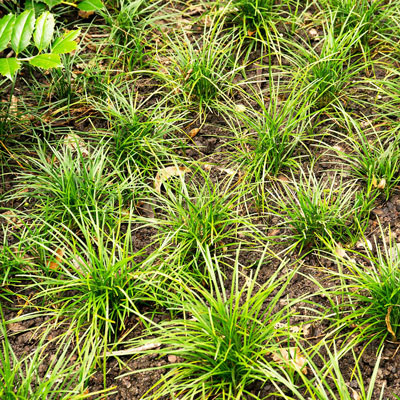
Photo: New clumps of mondograss two months after planting.
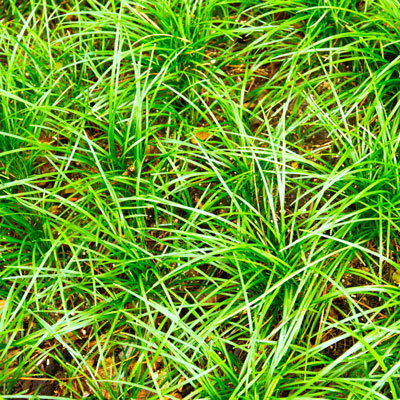
Photo: By 12 months after planting, mondograss has really begun to fill in.
I’d like to be able to tell you there’s a lot more to growing mondograss as a groundcover, but honestly, that’s about it. Stand back and enjoy it. It’s going to be a great friend.
I’m going to include a few other photos of mondograss.
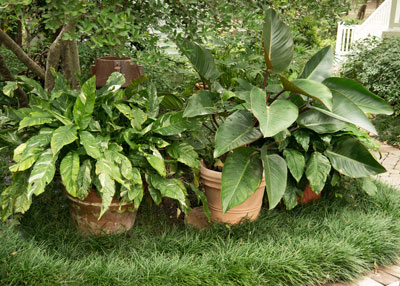
Photo: I put concrete round stepping stones in place in my mondograss. In winter they’re just neutral elements within the beds, but in summer I can put large tropical plants on them for interest.
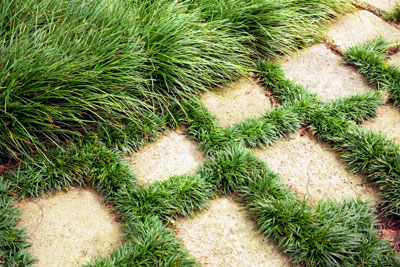
Dwarf mondo is fine for use between stepping stones and in small spots in the front of a bed, but for large-scale groundcover, regular mondo (top) is the choice.
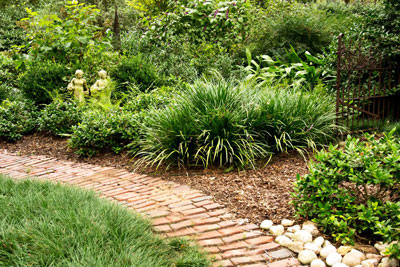
Giant liriope is an attractive 16-inch-tall accent, but it would be too tall as a groundcover. (Regular mondo in foreground.)
